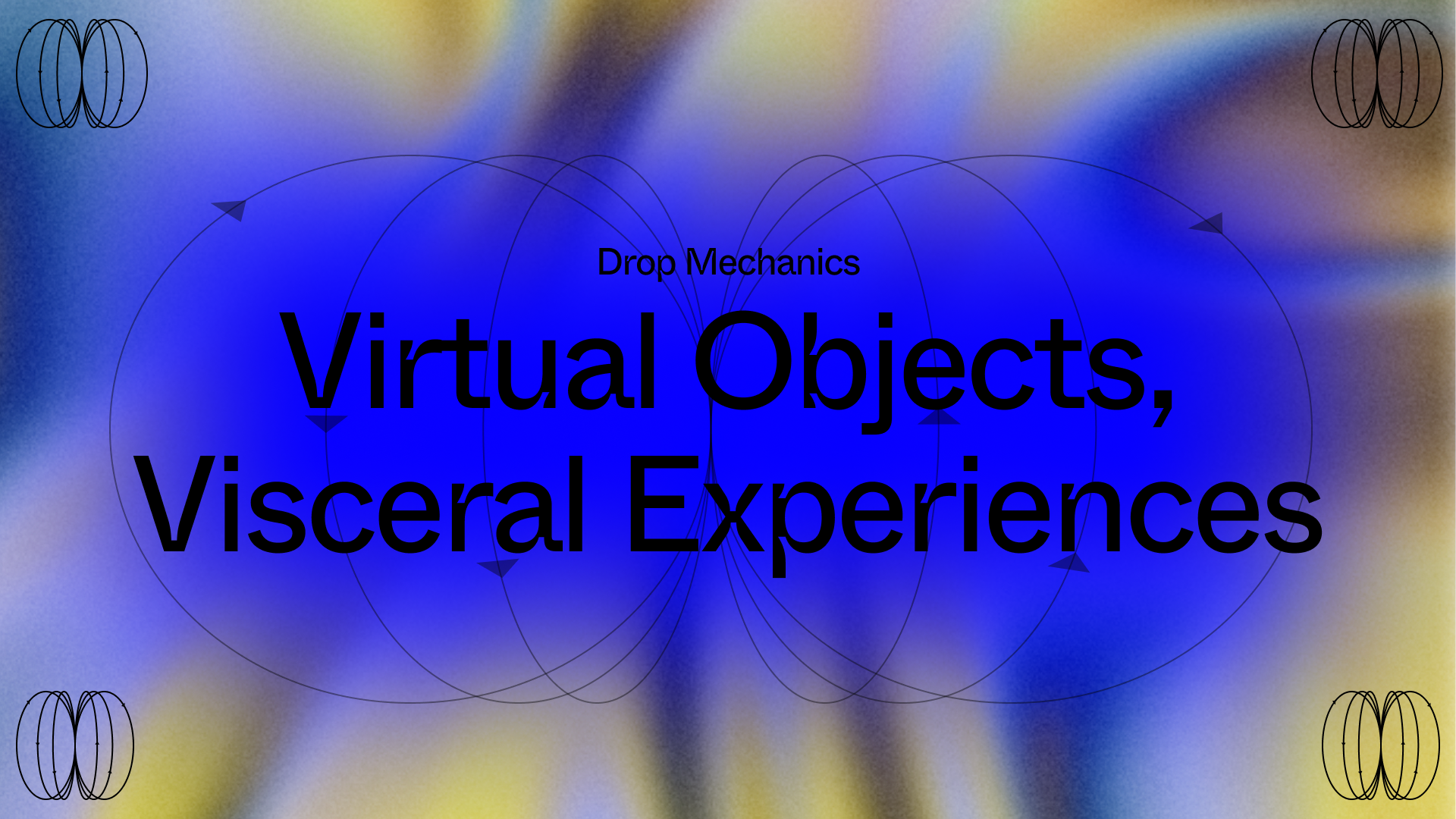A framework for physical-digital drops.


Over the course of the past year, more than 100 brands have released NFT projects. Many of them have been experiments. Some of them have been breakout successes. But as web3 initiatives, they each work to transform the relationship between brand and fan: shifting it away from passive views into something more substantial—shared ownership, and shared space.
NFTs build a bridge between our digital and physical worlds; providing a connection point that adds meaning and value to both realms. By designing digital collections for visceral, physical experiences, brands and IP can tap into a powerful lever for onboarding new audiences into web3
Understanding collection drivers, on and offline.
From comic book fans to hypebeasts: many communities see the value in physical collectibles. But many more are understandably unsure when it comes to collecting digital goods.
Physical collectibles can be worn, displayed; they have a tactility that’s hard to replicate digitally. That said, digital collectibles also have their own unique properties that can enhance fan experiences. To win over web2 and physical collectors, it’s about the offline roots of collecting: artifacts that tell a story, that demonstrate value, that signal identity, that signify belonging. This is about growing existing behaviors among your audience, not creating new ones.
A framework for physical-digital drops.
A physical-digital drop bundles physical goods with their virtual twins, demonstrating the value of virtual collecting through design, experience, and relationship. This type of drop closes the gap between order and physical delivery, while creating new connection points between brand and fan.
Fans get instant access to their collectible: While waiting for the physical figure, artifact, or article of clothing, fans can instantly redeem a collectible that corresponds to it.
Digital becomes a proxy for physical: Until the physical is distributed, the digital collectible will act as its proxy, allowing collectors and platforms to immediately see value. Once the physical collectible is released, the digital collectible retains value, allowing for further monetization via secondary market.
Platforms benefit from organic, highly motivated engagement: The period between digital and physical distribution provides a natural mechanism to drive tune in into the collectible platform, creating entirely new touchpoints for brand engagement, education, and onboarding. Following physical distribution, the digital collectibles can be used as access passes for future brand initiatives.
Something you can touch through the screen.
Dispel the stereotype that this is a jpeg. If web2 fan communities are going to warm up to digital collecting, it’s critical to integrate the aesthetics and experience they expect. These artifacts should have qualities that evoke physicality. How do you make a virtual object that feels like a real one?
DC: FanDome collectibles pair physical storage devices with motion and dimensionality. You feel like you can hold them.
Adidas: Into The Metaverse collectibles borrow textures and motifs from action figures. You immediately have a physical frame of reference.
Nike X RTFKT Cryptokicks render one of the brand’s most recognizable silhouettes, and pair it with customization. You can see yourself in them.
What these, and other successful onboarding collections have in common is a profound tactility. It’s a superpower feeling: like you can reach through the screen.
High production value. Low complexity.
In certain types of collections, rarity can be implemented as a lever to increase buyer interest, adding excitement and variance. But not every collection requires rarity, and its inclusion can have a dilutive effect on the collection if implemented without intention.
Overcomplicated rarity systems can cause confusion, distract away from the core of the campaign, and add to marketing lift. Physical-digital collections should feel precious in their own right. For this type of collection, 1-3 simple, but polished designs are needed. These designs should feel like real objects, based on custom, and not premade, art.
Don’t compromise on production to hit an arbitrary number of variants. A satisfying collectible will have the greatest impact on your fans.
Simple functionality with a strong emphasis on the object itself.
Complicated feature sets aren’t necessary for every collection; if not well executed, these systems can cause static. Features should be easy for fans to grasp, and sustainable for platforms to roll out.
The goal for these physical-digital collectibles is simple. The digital object redeems for its physical counterpart (or vice versa). That means that both objects must be capable of exciting your fans.
Remember, physical memorabilia collectors do it for the pure enjoyment of ownership. The experience of the physical-digital objects is critical. It's about satisfaction, not stacked features.
Reference Projects
Adidas | Into The Metaverse
A 30,000 collection of two similar collectible variants built bridges with incumbent web3 brands, and featured a simple, physical-digital utility. They made $22,000,000 in an afternoon.
Revenue:
Primary: $23,000,000
Secondary: 4600 ETH
Features:
In the first phase, the holder of the NFT can redeem the NFT for a variety of physical merch at an undisclosed time. The second phase begins with an airdrop. And the third phase is up to you. “You. In the metaverse. A creation…”
Success Factors:
Community is key. Adidas went out of their way to build bridges with existing web3 brands, creating a mutually beneficial relationship for all involved parties. The project was visible and championed by the brand's main Twitter accounts. The communication to fans was consistent, and transparent: down to refunds for an error in gas fees.
Every touchpoint for the project is highly considered, and curated. The project dropsite offers an immersive digital world for fans to explore, while NFT features are simple, and clearly outlined.
Damien Hirst | The Currency
A 10,000 edition drop of systematically created art by contemporary art titan Damien Hirst presents the buyer with a tough choice. Does physical art, or digital art, hold more value?
Revenue:
Primary: $18,500,000
Secondary: 1100 ETH
Features:
The NFT corresponds exactly to the physical object the user would receive. Owners of the NFT were given about a year of time during which they had to decide on whether or not to keep the NFT and burn the physical version of it, or vice versa.
Success Factors:
Damien Hirst is one of the biggest names in the contemporary art space, and this project successfully leverages his name through thoughtful integration of blockchain modalities into a piece of conceptual art.
The physical pieces feel premium, with all of its details carefully documented for people to see. For new and experienced collectors, there was navigation: the project was deeply reported, with strong, active participation from the artist.
Tiffany’s | NFTiff
A provocatively expensive 250 edition drop that entitled the user to a custom pendant of a Crypto Punk in their possession.
Revenue:
Primary: $12,500,000
Secondary: $3,403,934
Features:
Owners of the NFT were given a short window of time (just one week!) to redeem their NFT in tandem with a Crypto Punk in their wallet. The NFT redeemed for a pendant in the visage of their crypto Punk, with a chain.
Success Factors:
Tiffany's creative director and the brand's main account have well-known NFTs as their pfps, and the creative director has been engaging with people in the space for months prior to the drop. The Tiffany’s drop utilized a small collection size while targeting Punk owners, a group known for its deep pockets and love of flexing and clout.
The physical collectible is designed to appeal to collectors (and the media!), ensuring both an existing audience of buyers, as well as massive social amplification.
In summary: what physical-digital drops can do for engagement.
Physical-digital collections can provide an effective mechanism for brand growth, product monetization, and community development: generating new revenue streams for platforms, and creating meaningful experiences for fans.
The distribution of digital and physical objects creates a natural platform-orientation and tune in for messaging from your brand. This group can be activated again and again, based on insights generated from these interactions.
Above all else, this is a framework that derives impact from the value of the objects themselves: the design of the physical good, the art of the digital collectible. This value can be augmented by access and surprise airdrops over time; deepening and transforming the relationship you have with web2 fans. Eventually, they’ll become familiar with NFT systems without even realizing it. (^_−)☆







